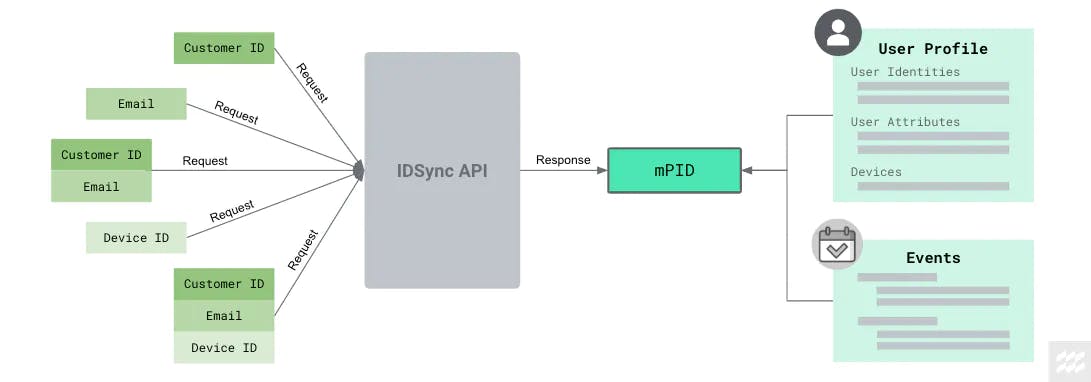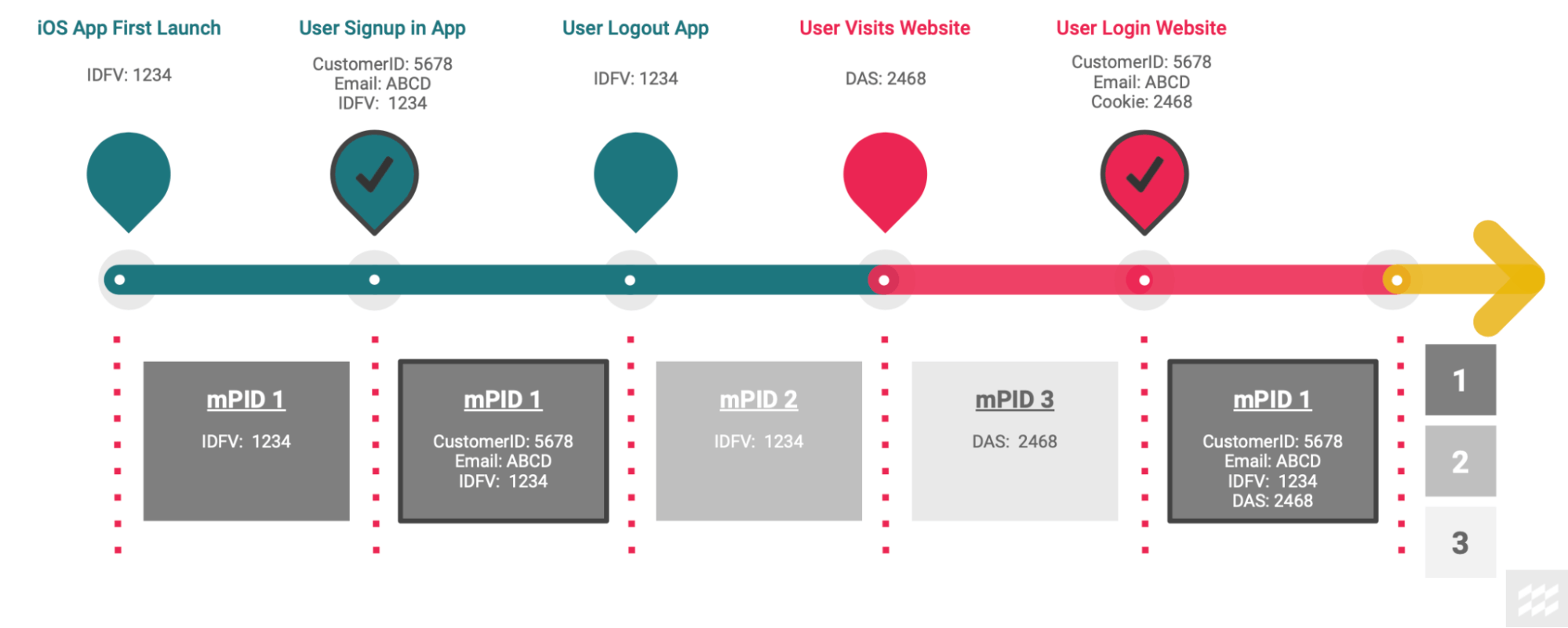What is identity resolution and how does it work?
Building a 360-degree view of the customer is critical for personalizing the customer experience and supporting customer data privacy. Learn more about identity resolution, the process of unifying data from different sources and making it actionable for teams across the business.

A customer searches your mobile website for women’s winter boots. They click on a banner to download your mobile app for a better experience, then get distracted by life. Hours later, they visit your website on a desktop to continue the search. Ultimately, they make a purchase the next day, via the mobile app. Three months later, they click on one of your Instagram ads for women’s sandals and buy a pair without leaving the Instagram app.
Disparate, omnichannel customer journeys like this are the norm today—the average customer now requires at least six touchpoints before making a purchase. Can your marketing tech stack track engagement across all those devices, unify it to a single customer profile, and use that data to power personalized product experiences and frictionless customer service?
According to data from IAB, 60% of marketers say their biggest challenge lies in connecting the dots across omnichannel customer journeys.
That’s where identity resolution comes into play.
What is identity resolution?
As Gartner defines it, identity resolution is “the discipline of recognizing people across channels and devices, and associating them with information used for marketing and advertising. It uses a constellation of tools, techniques and data.” These include:
- Tagging and tracking users across channels
- Linking identifiers across all the channels and devices a customer uses
- Building 360-degree customer profiles that can be activated across your tech stack
- Solving for consumer privacy preferences and compliance
A good identity framework stitches customer behavior from across devices and time, tying all relevant engagement to a holistic customer profile.
“Managing identity,” according to Gartner, “can power more effective multichannel engagement, improve targeting and creative tactics, and make measurement more accurate.”
But that’s not all. Effective identity resolution powers deeper, more accurate product insights and enables privacy teams to more effectively manage data governance and compliance.
A quick note on probabilistic vs. deterministic identity resolution
One of the first questions teams face when setting out to resolve cross-channel data to a unified profile is whether to use probabilistic or deterministic identity resolution methods.
Probabilistic modeling uses predictive algorithms to match behavior to the user profiles they probably belong to. Deterministic matching uses first-party data to link engagement to user profiles only when common personally identifiable information (PII) is shared.
Predictive algorithms are rarely 100% accurate, so there’s a margin for error baked into probabilistic matching. That may be fine for analytics use cases where you’re looking for ballpark numbers and the stakes for getting identity resolution wrong are low. Probabilistic ID resolution should never be your core identity resolution strategy, however, as delivering 1:1 personalization based on inaccurate customer profiles can lead to poor customer experiences and wasted budget.
Deterministic matching, on the other hand, prioritizes accuracy—something that’s absolutely vital when you’re delivering 1:1 personalized experiences to customers. When the customer experience is directly impacted, the stakes are high.
Why is identity resolution important?
Identity resolution is a key part of any effective data strategy, and it’s an element that benefits teams across the organization, from marketing and growth to product and even support teams.
With unified customer profiles:
- Marketing teams can deliver highly targeted, personalized messaging and offers
- Product teams acquire deeper insights into user journeys and personalize in-product experiences
- Privacy teams can manage data governance and ensure compliance more easily
The most important identity resolution use case for marketers, in particular, centers around personalization. With holistic customer profiles, marketers can hyper-target every aspect of their messaging. Personalization is the new competitive advantage for modern brands, driving 10–20% higher marketing efficiency and cost savings, along with a 10–30% uplift for both revenue and retention, according to McKinsey.
With a universal and actionable identity framework, marketers can more effectively personalize experiences such as:
- Abandoned cart emails
- Loyalty programs and exclusive offers
- Ad targeting and messaging
What happens when you don’t have good identity resolution?
Let’s say you don’t have an effective identity framework today—maybe you’re using probabilistic matching for marketing use cases, relying on third-party data, or aren’t able to resolve cross-channel data at all.
Lack of identity resolution may lead to challenges such as:
- Incomplete or duplicate profiles
- Violation of consumer privacy regulations, such the GDPR
- Data quality issues
- A fragmented view of the customer journey
- Difficulty activating customer data across channels
The worse case is that you actively create bad customer experiences with inaccurate personalization. Identity is key because it’s the linchpin where good data gets activated—and it’s the exact point where high-quality data can go bad.
The right data attributed to the wrong customer profile is ultimately wrong, after all, and personalization based on bad data often creates a worse experience than no personalization at all.
How does identity resolution work in the mParticle Customer Data Platform (CDP)?
mParticle’s identity framework is called IDSync, and it uses deterministic matching to unify data across channels, devices, and time and build highly accurate customer profiles.
Within the platform, each new profile is assigned an mParticle ID (mPID), which determines how the mParticle Identity API ties incoming data to a unique customer profile. When new events are associated with a customer ID, email, device ID, phone number, or any combination of identifiers, the Identity API attributes that data to the associated customer profile and mPID.

All information for a particular user—any linked identities, user attributes, device information, and event history for that user—is stored within that mPID.
To get a better sense of how identity resolution works in mParticle, here's a brief demo overview of mParticle IDSync.
Identity resolution example
Let’s look at an example flow that follows a user through the signup funnel and across different touchpoints, using Profile Conversion identity resolution strategy:

- First, the user downloads and opens your iOS app. The only information available to mParticle is the IDFV of the user’s phone, so mParticle resolves the user to a new anonymous profile. We’ll call this mPID 1. From this point forward, any actions connected to that IDFV resolve to mPID 1.
- Once the customer logs in through the app, mParticle converts mPID 1 to a logged in profile and adds the login identifiers to the mPID 1 profile.
- Let’s say the customer then navigates to your website through their desktop browser. The only information available is the dynamically-generated Device Application Stamp (DAS) attribute, so mParticle resolves the user to another new anonymous profile—mPID 2.
- Once the user logs in via the browser, mParticle finds a previous match for those login identifiers: mPID 1. Now, mPID 2 is converted to mPID 1 and any actions from this point forward are resolved back to mPID 1.
What data do you need for identity resolution?
There’s no hard and fast rule for how much or what type of data you need to power your identity framework. You can start from anywhere, but the more data you have, the richer your customer profiles will be.
Building customer profiles based on first-party data is always more reliable than using third-party data. Third-party data can be useful for enriching your existing first-party data, but can lead to data quality issues when used as the primary source for identity resolution.
With first-party data, you have much more control over the quality of the data and how it’s collected, making for better data governance and more accurate customer profiles.
The mParticle Customer Data Platform (CDP) for example, collects customer data and creates your first-party customer profiles. Your CDP should act as a single unified source of truth for your customer identities, continuing to make sense of additional data and make profiles more complete.
To learn more about what exactly Customer Data Platforms are and why they matter for identity resolution, you can check out our complete guide to Customer Data Platforms here.



